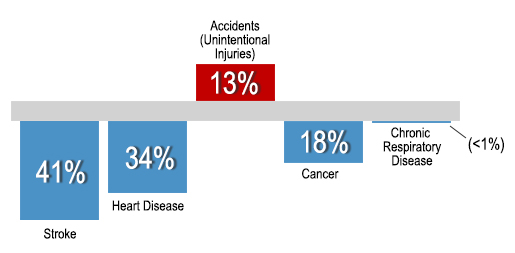There won’t be a lengthy trial or jail time for these killers but each one was responsible for over 100,000 fatalities in 2013 (the most recent year for which data is available). The top five causes of death in the United States from 2013 are:
- Heart disease: 611,105
- Cancer: 584,881
- Chronic lower respiratory diseases: 149,205
- Accidents (unintentional injuries): 130,557
- Stroke (cerebrovascular diseases): 128,978
One of these causes is not like the others. Four are chronic diseases that we spend billions of research dollars every year trying to cure. The fifth is unintentional injuries.
A growing danger
Not only are unintentional injuries one of the leading causes of death, but they’re also one of the few causes that are actually increasing.
According to the Centers for Disease Control and Prevention (CDC), from 2000 to 2013 stroke had a 41% decrease, heart disease had a 34% decrease, cancer had an 18% decrease and chronic respiratory diseases had a marginal (less than 1%) decrease. The only one of the top five to increase was accidental deaths, which grew by 13%. So while we’re getting better at preventing some of the big killers, little has been done to stem the tide of deadly accidents.

Who’s affected?
Another difference between unintentional injuries is that they tend to affect a wider demographic than the other leading causes of death. The chart below (from data provided by the CDC) shows the death rates per 100,000 people and unintentional injuries are the leading cause for every age group under 45—and in most cases it’s not even close.
According to Larry Wilson and Gary Higbee, the authors of Inside Out: Rethinking Traditional Safety Management Paradigms, unintentional injuries are the result of mental states like rushing, frustration, fatigue and complacency that can cause people to make a number of potentially dangerous errors. As a result, they can strike every age group, whereas chronic diseases primarily affect older people. While every death is tragic, unintentional injuries are more likely to claim the lives of children, teens and young adults than the other leading causes of death.

Limited scope of safety
There are safety precautions at home (permits for electrical work, warnings on power tools) and on the road (speed limits, police presence). But there’s a lot more direct influence and control of safety in the workplace, which also happens to be one of the places where employees are the least likely to be injured.
One of the reasons there are fewer injuries on the job is that many workplaces have implemented a number of safety-first engineering improvements. Conversely, when you look at off-the-job activities where people get hurt, like driving or home renovations, the biggest danger is distraction, and that’s not something a technical solution can fix.
No easy solutions (but things you can do)
There’s no instant cure for distraction and the other human factors that are propelling the increase in deaths from unintentional injuries. It will take a concerted effort to start improving personal awareness. And because most training occurs at work, employers, HR managers, plant managers and safety professionals are in the best position to teach people how to deal with human factors 24/7
Talk to your family about the dangers of taking their eyes and mind off what they’re doing. If you’re responsible for workplace safety then investigate training programs that help you reduce the biggest causes of injuries—rushing, frustration, fatigue and complacency.
Recognize that our state of mind is a factor in most unintentional injuries—and as long as we fail to address human factors, people will continue to die from unintentional injuries even as we develop more advanced safety engineering solutions.
And most importantly, learn more by registering for one of our free webinars on human factors or by understanding how specific workplace problems like slips, trips and falls are actually problems off the job too.
